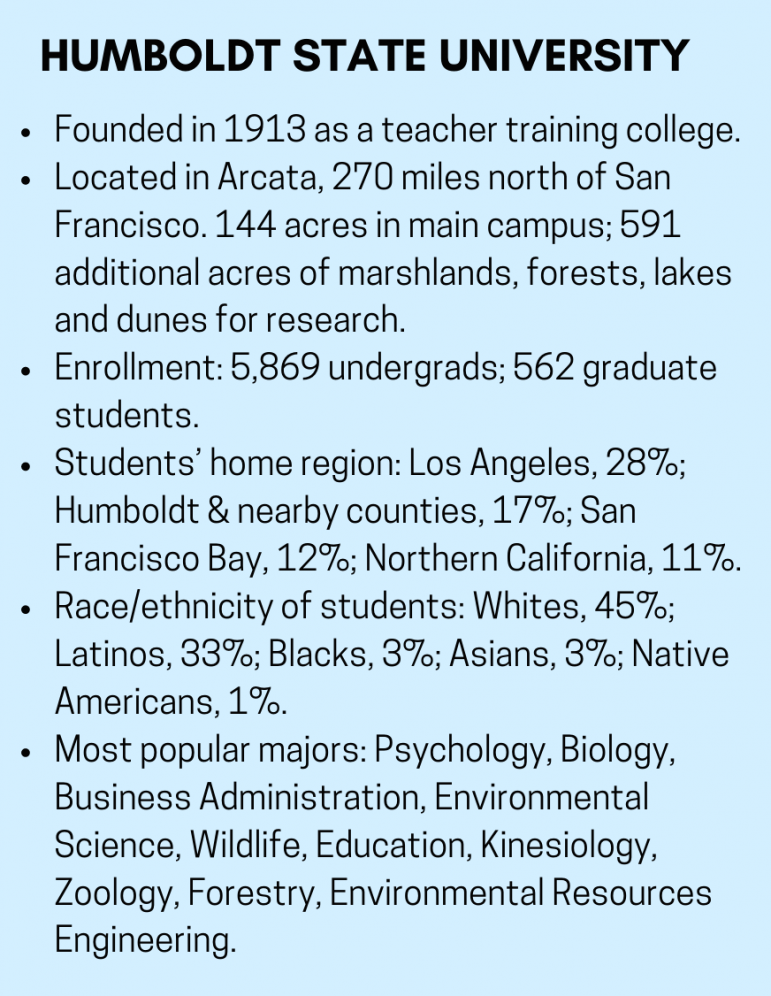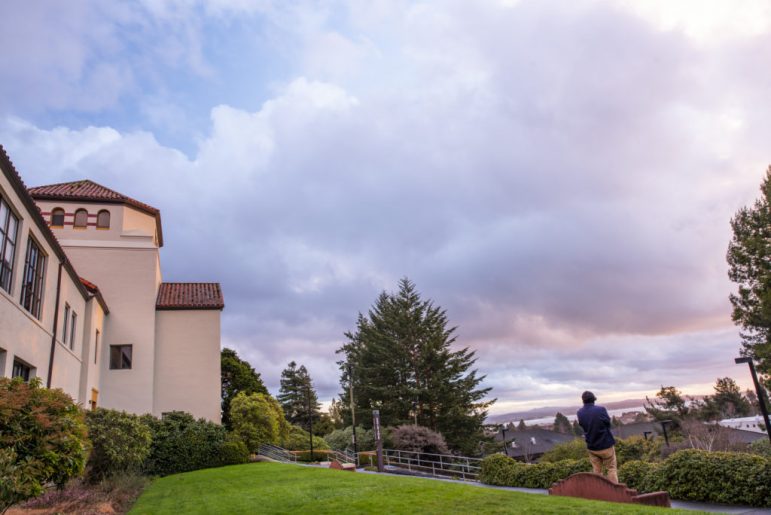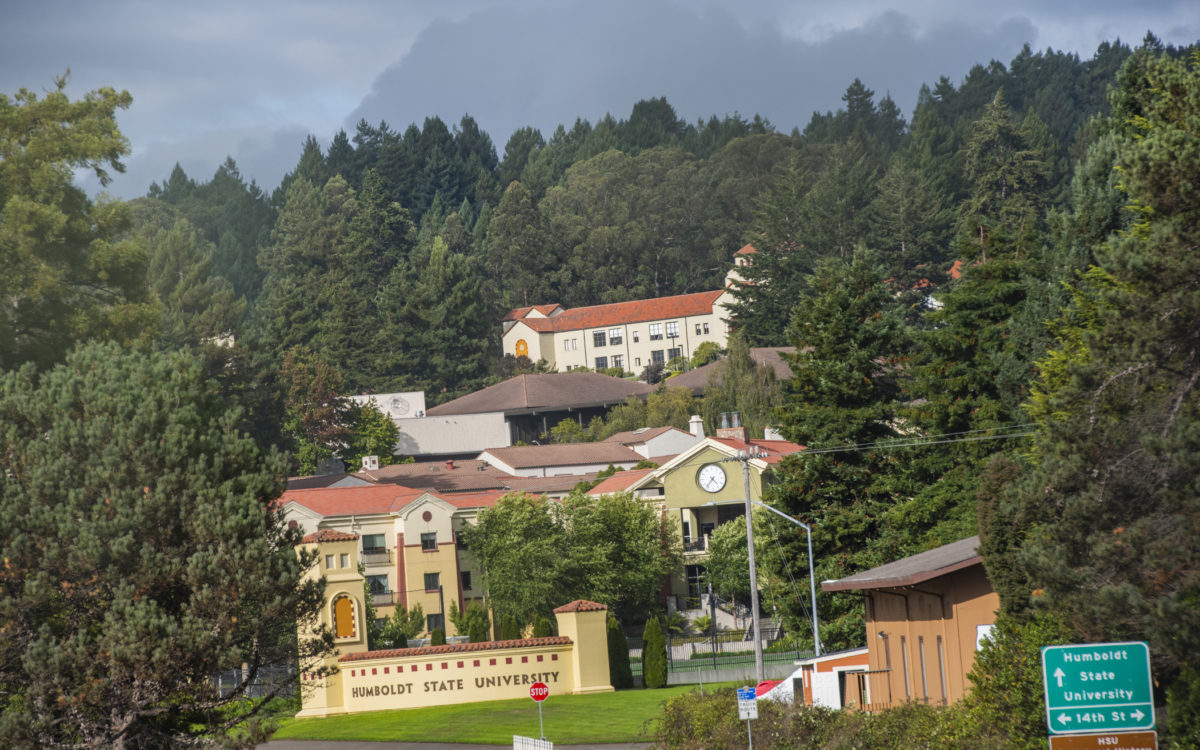Humboldt State, the most northern and arguably the most beautiful of the California State University’s 23 campuses, is having an identity crisis.
Located on the hills between Arcata Bay and a redwood forest 100 miles from the Oregon border, Humboldt State has been drastically and steadily losing enrollment for the past five years. Its overall student body shrank 26% since 2015 to 6,430 this past fall. Even more worrisome, its number of first-time freshmen plummeted 61% over those years to 546.
Now, an effort is underway to possibly reverse that enrollment trend and rebrand the campus’s identity, moving away from its reputation in some circles as an institution with a hippie vibe in a remote artsy town.
Humboldt State has begun a study to consider converting what is now a general-interest campus with lauded environmental programs into CSU’s third Polytechnic University, with a stronger emphasis on the sciences, technology and engineering.
Such a change would be the first of its kind in CSU history and potentially would open up seats in STEM majors for applicants crowded out at more popular campuses, officials say. It could also lead to more research funding from the federal government and private industry.
A Cal Poly Humboldt would become “increasingly attractive to students from around California and beyond, creating a robust and stable student body at the undergraduate and graduate levels,” former CSU system chancellor Timothy White wrote in the November letter asking the campus to investigate such a conversion.
Many details are not known yet. Those include: What programs and majors might be added or expanded? What would the costs be? When could this happen? And perhaps most unknown, would the change entice thousands more students from the population centers of Los Angeles, a 12-hour drive away and San Francisco Bay, five hours?
Because population in far northern California is declining, a turn in Humboldt’s fortunes would require the campus to attract students from across the state.

Giovanni Guerrero, a fourth-year student from San Diego who is the external affairs representative of Humboldt’s student government, said he thinks most students would support the change as a way “to draw more attention and investment to the university and bring up enrollment numbers.” A Cal Poly designation, as shown by the existing Cal Poly campuses in San Luis Obispo and Pomona, “has that prestige in it.”
He chose Humboldt because its seaside and rural setting is such a big change from his family’s urban home at the other end of the state. “I was passionate about being in the outdoors,” Guerrero said. He also was drawn to the school’s prestigious Environment Science and Management program, now his major.
Yet, he said he understands why other students from Southern California may feel Humboldt is too remote and that Arcata, once a center for the logging industry, is too small a town.
While Latinos like him now comprise 33% of Humboldt’s enrollment, Guerrero said the university does not offer enough support to students of color. Some of those students may not feel comfortable in Arcata, where an overwhelming share of its 19,000 residents are white.
A tragic episode also hurt the university’s image. In April 2017, David Josiah Lawson, a black student at the university, was stabbed to death at an off-campus party in Arcata. Police arrested and released one suspect and the case is considered unsolved.
The murder has caused some parents to steer their children away from attending Humboldt. Before recreational marijuana became legal, some families worried about a drug use culture at a school so close to the region’s cannabis growers.
In the past year, the pandemic and the switch to online classes across the CSU also hurt Humboldt enrollment, officials said.
Faculty emphasize that a switch to a Cal Poly would not be an enormous stretch. Some estimate that the campus already has about 80% of the courses and programs needed for the new designation.
Humboldt State offers popular degrees in biology, chemistry, nursing and computer science and touts its setting to attract applicants to majors in fisheries biology, oceanography and wildlife. Even its mascot, Lucky the Lumberjack, reflects that outdoors spirit. (However, some students want it changed to something less patriarchal and less conjuring of forest clear-cutting.)
The university already is reported to have the third highest percentage of students in the CSU enrolled in STEM programs — just behind Cal Poly San Luis Obispo and Cal Poly Pomona, officials say.
It continues a tradition of hands-on and field learning, another important trademark that sets a Cal Poly apart from regular campuses.
However, the campus does not offer traditional civil, mechanical or electrical engineering that are popular at other Cal Polys. All those may not be needed for a new type of Cal Poly as much as programs in health, sustainable agriculture, cybersecurity, fire protection and climate change, say advocates of the switch.
Mark Wilson, a biology professor who is vice-chair of the University Senate, noted that Humboldt’s location makes it a good place to expand biological sciences and applied sciences like forestry, wildlife and fisheries rather than try to replicate the other Cal Polys. “I don’t think either the goal or the vision is for us to become like them. The location here and the natural setting would really make a different university.”
He added: “We want to embrace this idea of a 21st Century Polytechnic University and not just rely on some old vision.”

Humboldt’s enrollment drop makes it easier to gain admission there in most programs than at the two existing Cal Polys. According to university data, only the wildlife and nursing majors are “impacted” at Humboldt, meaning that most applicants to those crowded majors must show academic records a step above basic CSU eligibility. In contrast, all majors at San Luis Obispo are impacted as are 20 majors at Pomona.
Those existing Cal Polys have increased their enrollments over the past five years, with Pomona rising the most, 25%. Even in this pandemic year, Pomona and San Luis Obispo grew 6.4% and 4.9%, respectively, while Humboldt’s enrollment declined 7.9%.
Jenn Capps, Humboldt’s provost and vice president for academic affairs, said the campus would keep its focus on social justice even with an identity change. The university would emphasize “science serving society,” she said, referring to research and career training to solve problems like climate change and health inequities.

Capps is co-chair of the campus’ study group examining the possible switch. With widespread support on campus for the change, the study is likely to probe how to do it rather than whether it should occur, she said. Subgroups will concentrate on such issues as academic planning, facilities, student success, fundraising and others. In all, at least 100 faculty and staff are serving on those committees.
A summary report may be completed by this summer or fall and then presented to the CSU Board of Trustees, which would have to approve it. Special appropriation from the Legislature may be needed as well. New and expanded programs could be phased in, starting in two years or so, officials said
Some fear that the change could inadvertently weaken the humanities and the arts.
However, that is not necessarily true, according to Alison Wrynn, the CSU system’s associate vice chancellor for academic programs, innovation and faculty development. She noted that the San Luis Obispo and Pomona campuses “still have robust departments in the humanities and the arts” and emphasized that even science majors still have to take degree requirement courses in the liberal arts.
Faculty in the arts and humanities initially were concerned about a Cal Poly designation, said art department chairperson Heather Madar. But with assurances that the university would still value those fields, she said opinions have shifted to “cautious optimism on how this would work out for us.” There may be more inter-disciplinary studies combining science with the arts and social sciences, “looking at a Polytechnic and infusing it with the Humboldt spirit,” she said.
